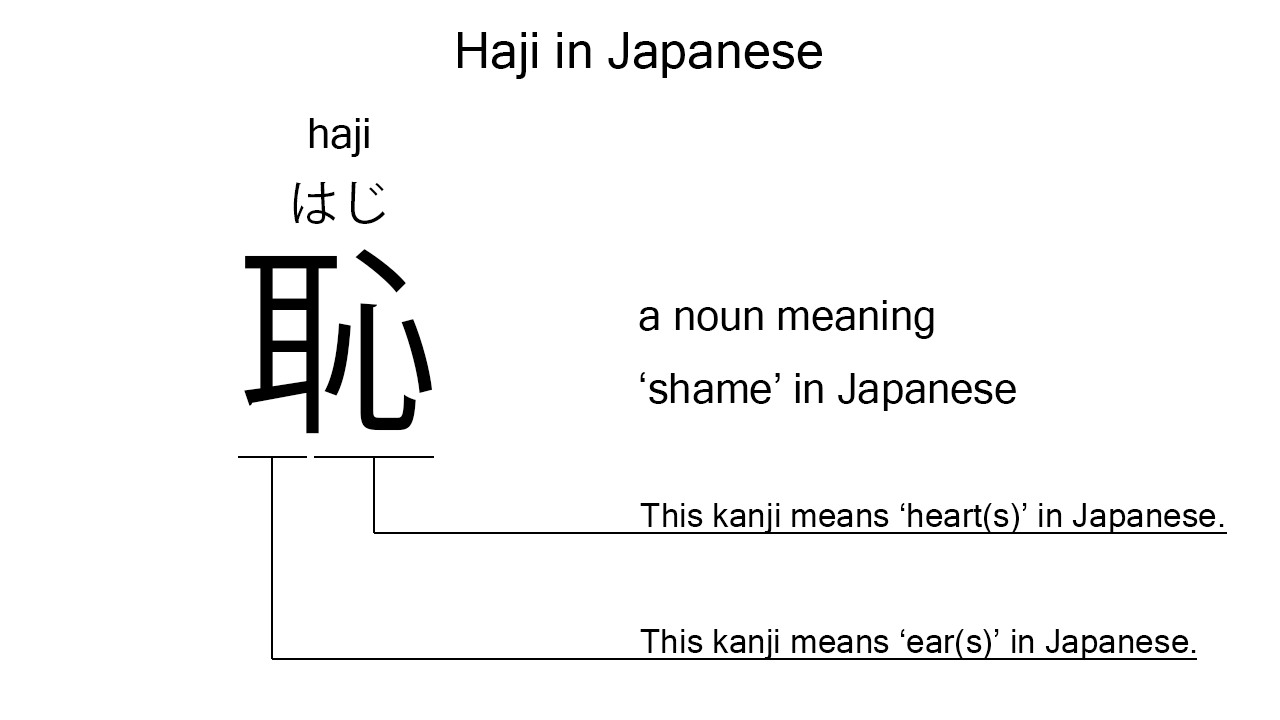What does “haji” mean in Japanese?
Native speakers say “haji” to mean ‘shame’ in Japanese. Perhaps, some Japanese learners know this word as it is sometimes used in Japanese movies, songs, novels, manga, anime, and the like. In this blog post, however, I will explain this word in detail based on its kanji character. And also, I will explain how to use it through example sentences. My explanations would help Japanese learners understand “haji” more clearly. Then, let’s get started!
Contents
Definition and meaning of “haji”
Let me start with the definition and meaning of “haji”.
- haji – 恥 (はじ) : a noun meaning ‘shame’ in Japanese.
Native speakers use this noun to refer to a feeling of embarrassment in Japanese. So, the usage is very similar to that of “shame” in English.
The definition and meaning are simple and clear. To understand this noun more clearly, however, let me explain its kanji character in detail.
What does “haji” literally mean in Japanese?
The kanji character of “haji” consists of the following two parts:
- 耳 : a kanji character used to mean ‘ear’ in Japanese.
- 心 : a kanji character used to mean ‘heart’ in Japanese.
These two kanji characters tell us that “haji” literally means an ‘ear heart’ in Japanese. This literal interpretation is not in line with the actual meaning, but interestingly still understandable. Our ears often turn red when we feel embarrassed. In Japanese, ears can be considered as indicators showing how we feel.

When we meet new kanji characters, we should check their parts in detail to understand their meanings clearly and deeply. In many cases, kanji parts tell us a lot about the meanings of the characters they form. Actually, here, we could get the better understanding of “haji” through the detailed check above.
So far, I’ve explained the definition and meaning of “haji” together with its kanji parts. Then, let me explain how to use it through the example sentences below.
Example #1: how to say “shame” in Japanese
kanojo wa haji wo shira nai – 彼女は恥を知らない (かのじょははじをしらない)
She has no shame.
Below are the new words used in the example sentence.
- kanojo – 彼女 (かのじょ) : a pronoun meaning ‘she’ in Japanese.
- wa – は : a binding particle working as a case marker or topic marker. In the example, this works after “kanojo” to make the subject in the sentence.
- wo – を : a case particle used to make the object word in a sentence. In the example, this is used after “haji” to make the object in the sentence.
- shira – 知ら (しら) : one conjugation of the verb, “shiru”, which means ‘to know’, ‘to get to know’, or such in Japanese. In the example, it has been conjugated for the better connection with its following word.
- nai – ない : an auxiliary verb used after a verb, adjective, or auxiliary verb to deny its meaning. In the example, this is used after “shira” to deny its meaning. Word orders in Japanese and English are different, but the role of this auxiliary verb is similar to that of “not”.
This is a typical usage of “haji”. In this example, it works as a part of the commonly-used phrase, “haji wo shira nai”, which literally means ‘not to know shame’ in Japanese. The phrase is often translated into English as “not to have shame”, though.
Example #2: another usage of “haji”
watashi wa haji no kankaku ga aru – 私は恥の感覚がある (わたしははじのかんかくがある)
I have a feeling of shame.
Below are the new words used in the example sentence.
- watashi – 私 (わたし) : a pronoun meaning ‘I’ in Japanese.
- no – の : a case particle joining two nouns. Normally, the first one can work as a modifier to describe the second. In the example, this works to join “haji” and “kankaku”. The formed phrase literally means a ‘feeling of shame’ in Japanese. Word orders in Japanese and English are different, but the role of this case particle is similar to that of the English preposition, “of”.
- kankaku – 感覚 (かんかく) : a noun meaning ‘feeling’ or such in Japanese. This can also work as plural. Learn more about Japanese plural.
- ga – が : a case particle used to make the subject word or the object word in a sentence. In the example, this is used after “haji no kankaku” to make the subject in the sentence.
- aru – ある : a verb meaning ‘to exist’, ‘to have’, or just ‘to be’ in Japanese.
This is another typical usage of “haji”. In this example, it works together with “no” and “kankaku” to mean a ‘feeling of shame’ in Japanese. When we want to mean ‘shame’ in Japanese, anyway, this noun is always a very good option.
The original meaning of the Japanese sentence is more like ‘for me, there is a feeling of shame’, but it has been translated in a more natural way.
Summary
In this blog post, I’ve explained the definition and meaning of “haji” in detail based on its kanji character. And also, I’ve explained how to use it through the example sentences. Let me summarize them as follows.
- haji – 恥 (はじ) : a noun meaning ‘shame’ in Japanese. The left part of this kanji character means an ‘ear’ in Japanese; the right one means a ‘heart’. So, this kanji character literally means an ‘ear heart’ in Japanese. This literal interpretation is not in line with the actual meaning, but interestingly still understandable. Our ears often turn red when we feel embarrassed. In Japanese, ears can be considered as indicators showing how we feel.
Hope my explanations are understandable and helpful for Japanese learners.
Leave a Reply